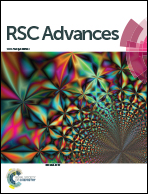The multi-channel reaction of the OH radical with 5-hydroxymethylcytosine: a computational study†
Abstract
The hydroxyl radical may attack the new cytosine derivative 5-hydroxymethylcytosine (5-hmCyt) causing DNA oxidative damage, but the study of the related mechanism is still in its infancy. In the present work, two distinct mechanisms have been explored by means of the CBS-QB3 and CBS-QB3/PCM methods, the addition of ˙OH to the nucleophilic C5 (R1) and C6 (R2) atoms and H-abstraction from the N4 (R3 and R4), C7 (R5 and R6), C6 (R7) and O3 (R8) atoms of 5-hmCyt, respectively. The solvent effects of water do not significantly alter the energetics of the addition and abstraction paths compared to those in the gas phase. The ˙OH addition to the C5 and C6 sites of 5-hmCyt is energetically more favorable than to the N3, C4 or O2 sites, and the ΔGs‡ value of the C5 channel is a little lower than that of the C6 route, indicating some amount of regioselectivity, which is in agreement with the conclusions of ˙OH-mediated cytosine reactions reported experimentally and theoretically. The H5 and H6 abstraction reactions are more favorable than other abstractions, which have almost the same energy barriers as those of ˙OH addition to the C5 and C6 sites. Moreover, the energies of the H5 and H6 dehydrogenation products, which formed benzyl-radical-like complexes, are about 62–101 kJ mol−1 higher than those of the adduct radicals, indicating that the H5 and H6 abstractions have a relatively high probability of happening. Accordingly, the proportions of the H5 and H6 dehydrogenation products are large and may be detectable experimentally. These findings hint that the new DNA base (5-hmCyt) is easily damaged when exposed to the surroundings of a hydroxyl radicals environment. Therefore the reduction of free radical production or the addition of some antioxidants should be done in mammalian brain tissues to resist DNA damage. Our results provide some evidence between 5-hmCyt and tumor development for experimental scientists.


 Please wait while we load your content...
Please wait while we load your content...